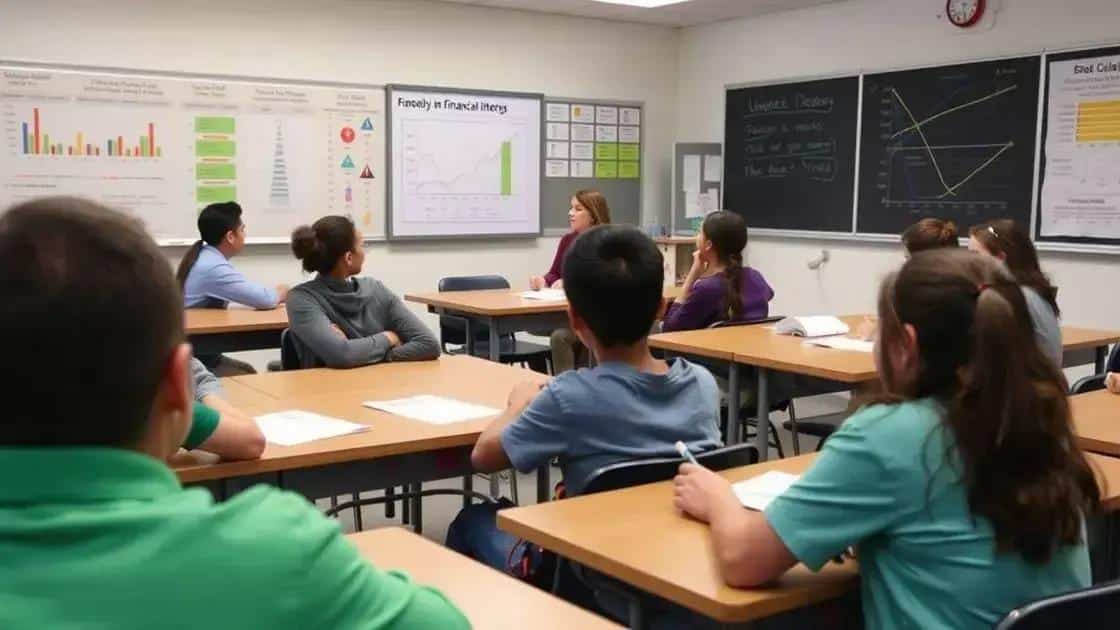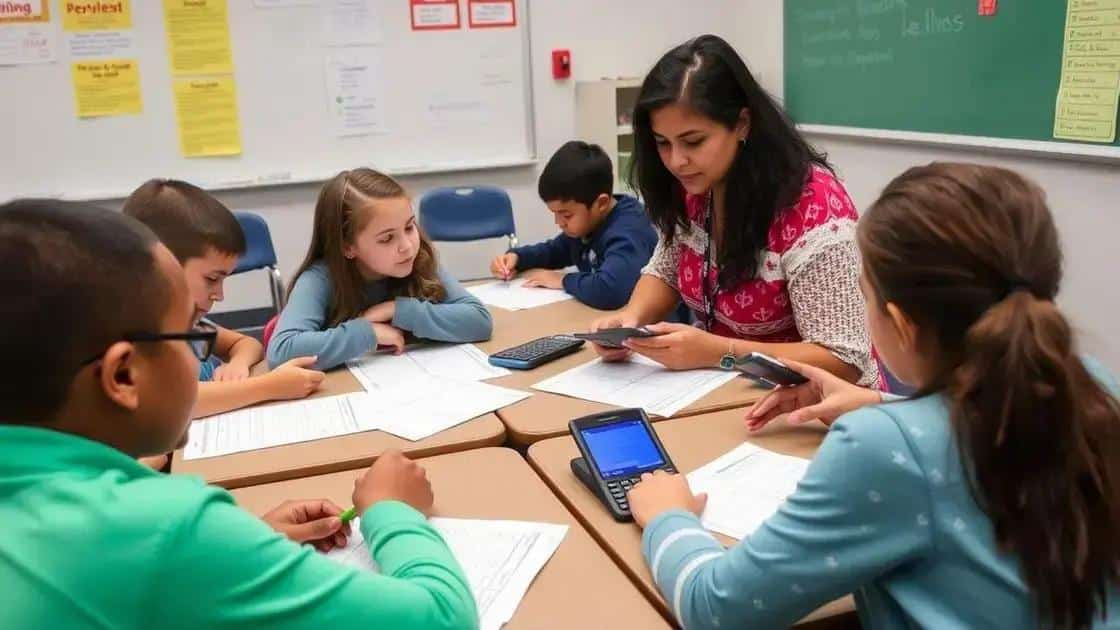Office financial literacy in schools: Why it matters

Integrating office financial literacy in schools equips students with essential money management skills through practical education, community resources, and real-world applications, paving the way for their financial success in the future.
Office financial literacy in schools is a topic that often goes unnoticed, yet its impact on students’ futures can be profound. Have you ever wondered how well-prepared our kids are for managing money? This article dives into the essentials of financial education and its necessity in today’s world.
Understanding financial literacy concepts
Understanding financial literacy concepts is essential for equipping students with the skills they need to manage money confidently. Financial literacy empowers young individuals to navigate the complex world of finance, helping them make informed decisions that will positively impact their futures.
First, let’s explore some key financial terms that every student should know.
Key Financial Terms
Being familiar with financial terminology is crucial. Here are some fundamental concepts:
- Budgeting: The process of creating a plan to spend your money wisely.
- Saving: Setting aside money for future use, particularly for emergencies or large purchases.
- Investing: Using money to buy assets that will potentially increase in value over time.
- Debt: Money borrowed that must be repaid, usually with interest.
Next, it’s important to understand why these concepts matter. For instance, budgeting helps students manage their daily expenses, enabling them to save for important goals. By learning about saving, students begin to appreciate the value of money and how to use it wisely.
Why Financial Literacy is Important
Financial literacy instills good money habits at a young age. When students learn about financial concepts, they are less likely to fall into debt traps later in life. Additionally, understanding the basics of investing can set them on a path to accumulating wealth, giving them the tools needed to create a secure financial future.
Another critical aspect of financial literacy is the ability to make informed decisions. When students learn about their options—like various savings accounts, investments, or credit card choices—they can weigh the pros and cons effectively. This knowledge enables them to choose what’s best for their personal finance journey, rather than relying on assumptions or impulsive decisions.
Why financial literacy matters for students
Why financial literacy matters for students is a fundamental question in today’s world. Understanding how to manage money is not just a skill; it’s a vital part of life. With the right knowledge, students can make informed choices that affect their financial futures.
Financial literacy equips students with essential skills. For example, mastering budgeting helps them plan their spending effectively. This skill enables them to allocate their money towards needs and wants, making sure they save for future goals.
The Importance of Early Education
Teaching financial concepts early can lead to lasting habits. Students who learn about savings are more likely to set aside money for emergencies and larger purchases. This helps diminish the risk of falling into debt later in life. Moreover, when they grasp the idea of investing, they can start to understand how their money can grow over time.
- Builds confidence: Financial literacy boosts self-esteem as students learn to manage their finances.
- Reduces financial stress: Understanding finances leads to better decisions, lowering anxiety around money.
- Fosters independence: Knowledge of financial principles enables students to make their own informed choices.
- Encourages planning: Students learn to set financial goals, leading to a more responsible approach to spending.
Moreover, financial literacy can improve students’ overall academic performance. As they become more organized in handling money, they may also exhibit better organizational skills in their studies. This connection illustrates that learning about finances transcends mere money management; it fosters critical thinking and decision-making skills.
Students equipped with these financial tools are better prepared to face real-world challenges. They learn to navigate complex financial situations, from understanding loans to managing credit cards. With these insights, they can avoid common pitfalls like excessive debt and poor spending habits.
Practical skills students should learn

Practical skills students should learn in relation to financial literacy are essential for their future success. These skills empower students to take control of their financial lives and make informed decisions. From budgeting to investing, having a solid foundation in practical financial skills is crucial.
One important skill is budgeting, which helps students understand where their money goes. By tracking their income and expenses, they can see patterns in their spending. This not only encourages mindful spending but also helps them set savings goals.
Key Practical Skills
Here are some practical skills every student should master:
- Creating a budget: Learning how to plan expenses based on income is vital.
- Saving techniques: Understanding how to save effectively for both short-term and long-term goals.
- Understanding credit: Learning about credit scores, credit cards, and their implications.
- Investment basics: Gaining insight into how to invest money and the risks involved.
Moreover, another essential skill is understanding the concept of interest. Knowing how interest works, particularly in loans and savings accounts, helps students recognize the costs associated with borrowing money. This knowledge can prevent them from taking on debt they cannot manage.
As students learn about these skills, they also develop critical thinking abilities. They can analyze financial situations, weigh options, and make decisions that positively affect their financial health. This process fosters a sense of responsibility and accountability.
Real-Life Applications
It’s beneficial for students to practice these skills in real-life scenarios. For instance, setting up a mock bank account or using budgeting apps can enhance their learning experience. By applying what they’ve learned in a practical way, they can see the direct impact their skills have on their lives.
Additionally, students should be encouraged to participate in discussions about financial topics. Joining clubs or workshops focused on finance can further enhance their understanding and give them a platform to share ideas with peers. This collaborative learning environment makes financial concepts more relatable and engaging.
How to integrate financial literacy in the curriculum
How to integrate financial literacy in the curriculum is a crucial step in preparing students for real-world challenges. By weaving financial literacy into various subjects, schools can provide students with a comprehensive understanding of personal finance.
One effective approach is to incorporate financial literacy into existing subjects. For example, math classes can teach budgets and percentages, while social studies can explore economic systems. This method shows students how financial concepts apply in different contexts.
Practical Strategies for Integration
Here are some practical strategies to integrate financial literacy:
- Cross-curricular projects: Develop projects that require students to create budgets or analyze market trends, connecting finance with science or math.
- Guest speakers: Invite local financial experts to discuss relevant topics such as saving, investing, and managing debt.
- Workshops: Organize workshops focused on skills like resume writing, job interviewing, and understanding paychecks and taxes.
- Real-life simulations: Use role-playing games where students manage a budget, make investments, or navigate financial decisions in a simulated environment.
Additionally, teachers can use technology to enhance financial learning. Online simulations and apps can make budgeting and investing interactive and engaging. These tools help students visualize how their choices impact their financial futures.
Moreover, it’s important to create a supportive environment for discussing finances. Encourage open discussions about financial challenges and strategies during class. This fosters a culture of learning and sharing, making students feel more comfortable addressing their financial futures.
Collaboration with Parents and Community
Integrating community resources can also enrich financial literacy education. Schools should collaborate with local businesses and organizations that offer financial workshops or mentorship programs. Engaging parents in the learning process further amplifies the importance of financial literacy at home.
By connecting classroom learning with real-world applications and community resources, students can better understand the significance of financial literacy. This holistic approach prepares them for responsible financial decision-making and enables them to navigate their financial futures effectively.
Community resources to support financial education
Community resources to support financial education play a vital role in enhancing students’ understanding of money management. By utilizing local organizations and resources, schools can provide students with real-world insights and practical skills.
Local banks and credit unions often offer programs geared towards financial literacy. Many have resources such as workshops, online materials, and even guest speakers who can share their expertise. These partnerships can bring real-life experiences into the classroom, making learning more relevant.
Types of Community Resources
Here are some valuable community resources that can support financial education:
- Workshops and seminars: Many organizations host events focusing on budgeting, saving, and investing, providing practical knowledge to students.
- Mentorship programs: Connecting students with financial professionals can give them insights into real-world financial decision-making.
- Educational materials: Many local libraries and community centers offer free resources and books on financial literacy that students can access.
- Online platforms: Websites created by non-profits often provide free courses and programs to teach financial skills effectively.
Additionally, schools can collaborate with local businesses to provide hands-on learning experiences. For example, students could participate in internships or job shadowing opportunities that allow them to witness financial management in action. This direct involvement can ignite interest and solidify their understanding of financial concepts.
Engaging parents in the educational process is also crucial. Schools should inform parents about community resources available to them, so they can reinforce lessons at home. Hosting family nights where financial topics are discussed can also create a supportive atmosphere where knowledge is shared among families.
Getting Involved in the Community
One way students can take advantage of community resources is by volunteering with local organizations that teach financial literacy. This opportunity not only enhances learning but also helps students give back to their community. It can empower them to use their knowledge to help others, shaping them into responsible citizens.
Incorporating community resources into the financial education curriculum can create an enriching learning environment. Students will gain invaluable skills while building connections with local organizations, ensuring that they are well-prepared for their financial futures.
FAQ – Frequently Asked Questions about Financial Literacy in Schools
Why is financial literacy important for students?
Financial literacy equips students with the skills to manage money, avoid debt, and make informed financial decisions, setting them up for future success.
How can schools integrate financial literacy into the curriculum?
Schools can integrate financial literacy by incorporating it into math, social studies, and other subjects, using real-world applications and community resources.
What community resources are available to support financial education?
Local banks, credit unions, and community organizations often provide workshops, mentorship programs, and educational materials to enhance financial literacy.
How can parents get involved in their children’s financial education?
Parents can reinforce financial concepts at home, participate in school events, and engage in discussions about money management with their children.






